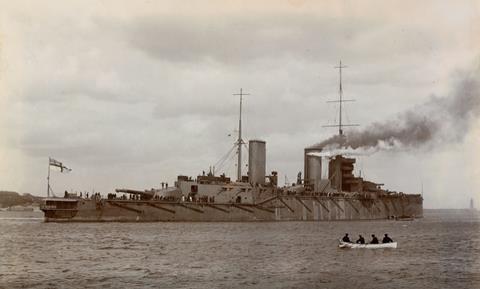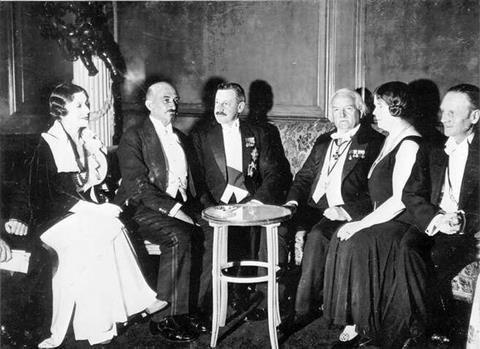Meera Senthilingam
This week, prepare for warfare, and possibly a manicure. Here's Lars Öhrström:
Lars Öhrström
On the morning of the 1st June 1916, the body of Royal Navy Boy telegraphist, 17 year old Arthur Cownden, was washed ashore close to the small fishing village of Fiskeböckskil on the Swedish west coast not far from Gothenburg. One of many victims of the battle of Jutland, the only major confrontation between the Royal Navy and the German fleet during the first world war, he had served on the destroyer HMS Shark. He would likely have been familiar with the smokeless gunpowder called cordite, so essential to the Navy, but was probably unaware of the critical role played in its manufacture by the nail varnish remover known to chemists and beauty queens alike as acetone.
Neither he, nor his ultimate superior Rear-Admiral David Beatty, could have foreseen how a few simple bugs and a Manchester chemistry professor would help boost cordite manufacture, saving the navy from a threatening shortage. Poor quality cordite was a potential risk to the Navy, and the standard MD quality was reserved for the fleet artillery, while cordite RDB, 'research department formula B', was supplied to the army. The key to the production problem was the lack of a good process for manufacturing acetone, a small organic molecule with the formula CH3COCH3, essential to the navy quality, but not necessary for the emergency RDB variety. But when Beatty saw the HMS Queen Mary explode and sink during the battle and commented: 'There seems to be something wrong with our bloody ships today', sub-standard cordite was probably not the problem, but rather the handling of this dangerous material, used as a propellant for the projectiles from the ships guns.

Today we still find acetone in nail varnish remover, but its low general toxicity and its non-existent neurotoxicity mean that this good solvent finds even heavier use in the paint and pharmaceutical industries. It is the simplest of all ketones, a class of molecules containing carbon-oxygen double bonds. As such it can participate in a number of reactions taught to undergraduate students of organic chemistry, yielding for example methyl methacrylate, a monomer used to prepare a number of very valuable acrylic polymers such as Plexiglas. This accounts for a bit less than 50 per cent of acetone consumption, but acetone is also one of the starting materials for a chemical now in serious disrepute, bisphenol A.
The large-scale manufacture of acetone, such a bottleneck for the first world war munitions factories, is today mostly accomplished by reacting two products from the petroleum industry, propene and benzene, together with oxygen from air. This yields phenol and acetone, in one of many examples from the chemical industry where two seemingly unrelated compounds are produced in the same process, just as milk and butter are produced in dairy. This may create interesting supply and demand problems, should the price of one of these commodities suddenly drop or rise dramatically.
In 1916, however, the petrochemical industry was still in its infancy and a fairly inefficient method using calcium acetate as the staring material was used to make acetone. This process could not meet the demands of the Royal Navy Cordite Factory in Holton Heath, Dorset, and serious research efforts were diverted in order to find a solution. Enter our chemistry professor from Manchester, a certain Chaim Weizmann, and his battalions of Clostridium acetobutylicum bacteria. Feeding them starch made them produce the desired acetone in such amounts as to make both the Minister of Munitions, David Lloyd George, and the First Lord of the Admiralty, Winston Churchill happy, and optimise the proportions of nitrocellulose, nitroglycerine and acetone in the cordite.

It has been claimed, perhaps most elegantly in the play Arthur and the acetone by George Bernard Shaw, that the Balfour declaration and, consequently, the foundation of the state of Israel, was a gift to Weizmann in recognition of this critical wartime effort. While this has been denied by Weizmann himself in his autobiography, as the scientific director of the British Admiralty Laboratories, certainly had the right contacts, and, moreover, was a political figure himself, becoming the first president of Israel in 1948.
As for the bacteria Clostridium acetobutylicum, they are not the only living organisms that produce acetone. This molecule turns up in the basic metabolism of most organisms; in humans it is mostly when we burn stored fat that acetone molecules will appear. This is only transient, of course, as the end products are carbon dioxide and water, but clever physicians may detect metabolic disorders by the distinctive, somewhat sweet smell of elevated acetone concentrations on the breath of a patient. Even the minute amounts produced by a healthy person can be detected, and the most recently proposed use of acetone is probably as a marker molecule to find earthquake and other disaster victims buried under heaps of rubble.
Meera Senthilingam
So, a wide array of applications. That was Lars Öhrström from the Chalmers tekniska högskola in Sweden, with the chemistry of the multi-talented compound acetone. Now, next week: some murder mystery.
Simon Cotton
'It isn't strychnine is it?' says one of the characters in the Mysterious affair at Styles, Agatha Christie's first published novel. But, of course, it is. And, of course, Hercule Poirot duly solves the mystery of the murder of Emily Inglethorpe.
Agatha Christie wrote 80 detective novels and became known as the Queen of crime. She was one of many writers to use the extreme toxicity of this molecule.
Meera Senthilingam
And to find out just how toxic strychnine can be, and the chemistry enabling this, join Simon Cotton in next week's Chemistry in it's element. Until then, thank you for listening. I'm Meera Senthilingam.













No comments yet